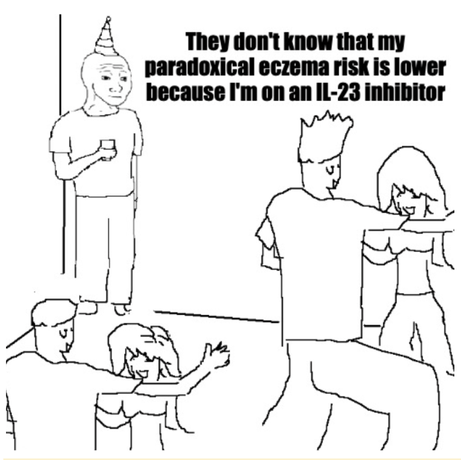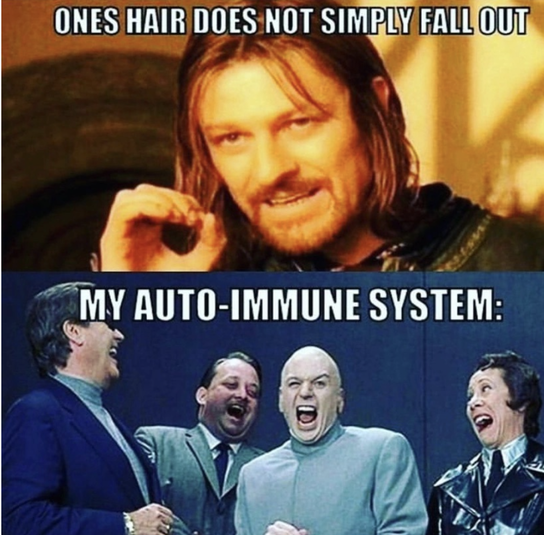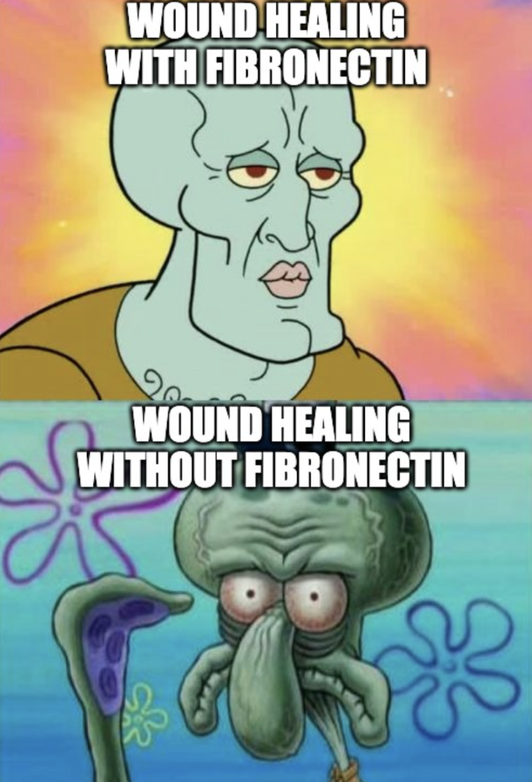Forty-Ninth issue
December 13th, 2023
IL-23: the psoriasis treatment that won’t “flake” on you!
Biologics that target TNF, IL-17, IL-12/23, or IL-23 effectively treat plaque psoriasis but have been linked to adverse cutaneous effects including paradoxical eczema, an atopic dermatitis (AD) phenotype with unknown risk factors.
Researchers conducted a prospective cohort study of 13,699 patients with plaque psoriasis treated with either TNF, IL-17, IL-12/23, or IL-23 inhibitors to investigate the correlation between biologic class and incidence of paradoxical eczema.
What did they find?
Limitations: Researchers could not determine whether each paradoxical eczema event was linked to the biologic or was a natural onset of adult eczema. The IL-23 inhibitor exposure number was low compared to other classes.
Main Takeaway: IL-23 inhibitors may pose a lower paradoxical eczema risk compared to other biologics, but this study should be replicated. Increasing age, history of AD or hay fever, and female sex may increase the risk of paradoxical eczema.
Biologics that target TNF, IL-17, IL-12/23, or IL-23 effectively treat plaque psoriasis but have been linked to adverse cutaneous effects including paradoxical eczema, an atopic dermatitis (AD) phenotype with unknown risk factors.
Researchers conducted a prospective cohort study of 13,699 patients with plaque psoriasis treated with either TNF, IL-17, IL-12/23, or IL-23 inhibitors to investigate the correlation between biologic class and incidence of paradoxical eczema.
What did they find?
- Among 13,699 patients, 24,997 drug exposures amounted to a total exposure time of 81,441 patient-years, with 273 exposures (1%) associated with paradoxical eczema
- The adjusted incidence rates of paradoxical eczema for each biologic were 0.94 per 100,000 person-years for TNF inhibitors, 1.22 per 100,000 person-years for IL-17 inhibitors, 0.80 per 100,000 person-years for IL-12/23 inhibitors, and 0.56 per 100,000 person-years for IL-23 inhibitors
- Demographics including increasing age (HR, 1.02 per year; 95% CI, 1.01-1.03) and AD (HR, 12.40; 95% CI, 6.97-22.06) or hay fever (HR, 3.78; 95% CI, 1.49-9.53) history were correlated with a higher paradoxical eczema risk, while male sex (HR, 0.60; 95% CI, 0.45-0.78) was correlated with a decreased risk
Limitations: Researchers could not determine whether each paradoxical eczema event was linked to the biologic or was a natural onset of adult eczema. The IL-23 inhibitor exposure number was low compared to other classes.
Main Takeaway: IL-23 inhibitors may pose a lower paradoxical eczema risk compared to other biologics, but this study should be replicated. Increasing age, history of AD or hay fever, and female sex may increase the risk of paradoxical eczema.
Crowning glory redefined: embracing strength in every strand lost!
Central centrifugal cicatricial alopecia (CCCA) is a scarring alopecia that begins as a patch of hair loss at the vertex scalp with centrifugal expansion. The etiology of CCCA is not fully understood but proposed risk factors include type 2 diabetes, bacterial scalp infections, and high-risk hair care practices such as coloring, relaxers, heat styling, and tight hairstyles.
CCCA predominantly affects women of African descent; there are only 16 published cases of CCCA in males. This case series retrospectively examined 17 male patients histologically diagnosed with CCCA between 2012-2022 to better understand and characterize CCCA in males.
What did they find?
- Patient ages ranged from 30 to 72 (mean age of 43); 88.2% of patients identified as Black or African American
- Scalp pruritus was the most common presenting symptom (76.5%)
- 17.6% acknowledged a history of high-risk hair care practices
- No patient was diagnosed with type 2 diabetes mellitus, but 17.6% had history of latent tuberculosis
- 47.1% had a positive family history of alopecia
- 29.4% of patients had an overlapping diagnosis on scalp biopsy
- Only 47.1% of patients fit the “classical” distribution (expanding outward from the vertex) of hair loss seen in females with CCCA
- 23.6% had diffuse/patchy distribution; 17.6% had occipital distribution
Main takeaway: While not common, it is important to consider a diagnosis of central centrifugal cicatricial alopecia (CCCA) in the differential for alopecia in adult Black males, keeping in mind the pattern of hair loss for CCCA in males can differ from that of females.
Fibronectin promotes wound healing in an atopic human skin xenografting model
Journal of Investigative Dermatology
Journal of Investigative Dermatology
Topical fibronectin: the fibroNEXTin treatment
Fibrotic skin remodeling in atopic dermatitis (AD) is mediated by an increase in Th2 cytokines and IL-4. Fibronectin (FN) is a component of the extracellular matrix that promotes wound healing, and previous studies have demonstrated that IL-4 suppresses FN gene expression in AD. Researchers sought to determine if topical FN application improves wound healing in AD.
Healthy human skin was transplanted onto immunodeficient mice. IL-4 was injected into transplanted human skin to mimic AD and punch biopsies were performed. Biopsy sites in control and IL-4 only groups were treated with petrolatum ointment and wound healing was compared to the IL-4 treated with topical fibronectin (IL4+FN) group for 5 days.
What did they find?
Main takeaways: Topical fibronectin application can improve wound healing in atopic dermatitis by preserving the expression of the FN1 gene that is usually suppressed by IL-4.
Fibrotic skin remodeling in atopic dermatitis (AD) is mediated by an increase in Th2 cytokines and IL-4. Fibronectin (FN) is a component of the extracellular matrix that promotes wound healing, and previous studies have demonstrated that IL-4 suppresses FN gene expression in AD. Researchers sought to determine if topical FN application improves wound healing in AD.
Healthy human skin was transplanted onto immunodeficient mice. IL-4 was injected into transplanted human skin to mimic AD and punch biopsies were performed. Biopsy sites in control and IL-4 only groups were treated with petrolatum ointment and wound healing was compared to the IL-4 treated with topical fibronectin (IL4+FN) group for 5 days.
What did they find?
- The IL-4 only group showed significantly delayed wound healing compared to the control group on day 3 (p<0.001) and day 5 (P<0.001)
- The IL-4+FN group significantly alleviated the delay in wound healing caused by IL-4 on day 3 and day 5 (p<0.001), confirming the therapeutic benefit of topical FN
- On RT-PCR, the IL-4 only group showed decreased expression of FN1 on day 3
- On RT-PCR, IL-4+FN group showed normal FN1 expression compared to the control group on day 3, indicating that topical FN treatment mitigates decrease in FN1 expression due to IL-4
Main takeaways: Topical fibronectin application can improve wound healing in atopic dermatitis by preserving the expression of the FN1 gene that is usually suppressed by IL-4.
Are anxiolytics safe and effective in relieving anxiety in Mohs micrographic surgery patients?
Journal of Dermatologic Surgery
Journal of Dermatologic Surgery
Be at your best without that perioperative stress!
Mohs micrographic surgery (MMS) can be anxiety-provoking for some patients. Previous studies investigated the use of benzodiazepines (BZD) to provide safe, short-term anxiolytic effects for MMS patients.
This placebo-controlled, double-blind, randomized trial investigated the use of non-traditional anxiolytic medications in patients (n=350) undergoing MMS, including multiple BZD, GABA-related compounds, and melatonin. Safety and efficacy were measured through patient self-assessment of anxiety, vitals, physician assessment of patient cognition, qualitative level of sedation, and postoperative patient satisfaction.
What did they find?
Main Takeaways: 5 mg of oral diazepam induced safe, sustained anxiolytic effects in MMS patients while short-acting BZD and GABA medications may provide transient anxiolysis.
Mohs micrographic surgery (MMS) can be anxiety-provoking for some patients. Previous studies investigated the use of benzodiazepines (BZD) to provide safe, short-term anxiolytic effects for MMS patients.
This placebo-controlled, double-blind, randomized trial investigated the use of non-traditional anxiolytic medications in patients (n=350) undergoing MMS, including multiple BZD, GABA-related compounds, and melatonin. Safety and efficacy were measured through patient self-assessment of anxiety, vitals, physician assessment of patient cognition, qualitative level of sedation, and postoperative patient satisfaction.
What did they find?
- Placebo showed significant decrease in anxiety over time (p < .001)
- Diazepam significantly reduced anxiety throughout postoperative period (p = .03)
- Gabapentin significantly reduced anxiety until the administration of local anesthetic for the first MMS stage (p = .02); alprazolam showed a nonsignificant trend for anxiety reduction (p = .08)
- Lorazepam (p = .73), pregabalin (p = .53), and melatonin (p = .24) failed to reduce anxiety at any time
- No statistically significant changes in vitals or cognition in any arm was observed
- All treatment arms had high patient satisfaction (mean score 9.1/10) with no statistically significant differences except for melatonin which had reduced patient satisfaction compared with placebo (p = .01)
Main Takeaways: 5 mg of oral diazepam induced safe, sustained anxiolytic effects in MMS patients while short-acting BZD and GABA medications may provide transient anxiolysis.
Drifting towards a new therapy for female androgenetic alopecia!
Androgenetic alopecia involves the miniaturization of hair follicles over the frontotemporal scalp, a process influenced by systemic androgen levels and genetics. Researchers evaluated the efficacy of combined non-cross linked hyaluronic acid (HA) compound with platelet rich plasma (PRP) in the treatment of female androgenetic alopecia (FAGA).
This retrospective case series included women with FAGA between 20-65 years old (n=9). Participants completed four sessions of non-cross linked HA compound and PRP microinjection into affected areas of the scalp every 4 weeks. The Ludwig classification, trichoscopy, and hair density was recorded at baseline, 1 month, and 3 month follow-up.
What did they find:
Main takeaway: Non-cross linked HA compound and PRP microinjection significantly improves hair growth and density in patients with female androgenetic alopecia.
Androgenetic alopecia involves the miniaturization of hair follicles over the frontotemporal scalp, a process influenced by systemic androgen levels and genetics. Researchers evaluated the efficacy of combined non-cross linked hyaluronic acid (HA) compound with platelet rich plasma (PRP) in the treatment of female androgenetic alopecia (FAGA).
This retrospective case series included women with FAGA between 20-65 years old (n=9). Participants completed four sessions of non-cross linked HA compound and PRP microinjection into affected areas of the scalp every 4 weeks. The Ludwig classification, trichoscopy, and hair density was recorded at baseline, 1 month, and 3 month follow-up.
What did they find:
- Eight patients (88.89%) showed one-point improvement in the Ludwig scale at 3-months compared to baseline
- All participants showed significant increase in hair counts at 1 and 3 months compared to baseline (p<0.001)
- Trichoscopy demonstrated significant growth in hair density within treated areas of alopecia after 3 month treatment
Main takeaway: Non-cross linked HA compound and PRP microinjection significantly improves hair growth and density in patients with female androgenetic alopecia.
Achenbach syndrome is a rare, benign, self-limiting condition characterized by episodic non-palpable, purpuric patches on one or more digits. Before these episodes, patients can report pain, swelling, and paresthesias. It is important to note that patients with Achenbach syndrome should be reassured of its benign prognosis and additional testing should be avoided.
Our team presented the case of a 66-year-old female patient who presented with waxing and waning non-palpable purpura for the last year on the palmar aspects of her digits bilaterally.
Achenbach syndrome is marked by a self-resolving hematoma on the palmar aspect of the digits. Physicians should be aware of Achenbach syndrome to both avoid unnecessary testing and advise patients of its benign prognosis.
Our team presented the case of a 66-year-old female patient who presented with waxing and waning non-palpable purpura for the last year on the palmar aspects of her digits bilaterally.
- Rheumatological evaluation revealed unremarkable CBC, CMP, and coagulation studies along with normal ESR, CRP without evidence of vasculitis or connective tissue disease
- Punch biopsy of the lesion was performed and dermatopathology revealed a perivascular lymphocytic infiltrate, extravasated erythrocytes, and pigmented macrophages consistent with a pigmented purpuric dermatosis
- Medical treatment for the patient included DerMend bruise cream
Achenbach syndrome is marked by a self-resolving hematoma on the palmar aspect of the digits. Physicians should be aware of Achenbach syndrome to both avoid unnecessary testing and advise patients of its benign prognosis.







